
- |<
- <
- 1
- >
- >|
-
Takuma Yamashita, Yuki Takahashi, Yoshinobu Takakura2018Volume 41Issue 6 Pages 835-842
Published: June 01, 2018
Released on J-STAGE: June 01, 2018
JOURNAL FREE ACCESS FULL-TEXT HTMLExosomes are cell-derived vesicles with a diameter 30–120 nm. Exosomes contain endogenous proteins and nucleic acids; delivery of these molecules to exosome-recipient cells causes biological effects. Exosomes derived from some types of cells such as mesenchymal stem cells and dendritic cells have therapeutic potential and may be biocompatible and efficient agents against various disorders such as organ injury. However, there are many challenges for the development of exosome-based therapeutics. In particular, producing exosomal formulations is the major barrier for therapeutic application because of their heterogeneity and low productivity. Development and optimization of producing methods, including methods for isolation and storage of exosome formulations, are required for realizing exosome-based therapeutics. In addition, improvement of therapeutic potential and delivery efficiency of exosomes are important for their therapeutic application. In this review, we summarize current knowledge about therapeutic application of exosomes and discuss some challenges in their successful use.
 Graphical Abstract Fullsize ImageView full abstractDownload PDF (1532K) Full view HTML
Graphical Abstract Fullsize ImageView full abstractDownload PDF (1532K) Full view HTML -
Toshihide Takeuchi2018Volume 41Issue 6 Pages 843-849
Published: June 01, 2018
Released on J-STAGE: June 01, 2018
JOURNAL FREE ACCESS FULL-TEXT HTMLMolecular chaperones have essential roles in cell survival, to prevent misfolding, aggregation, and aberrant accumulation of cellular proteins, and thus to maintain protein homeostasis (proteostasis). However, recent studies using animal models suggest that transcriptional upregulation of molecular chaperones in response to various types of stresses does not ubiquitously occur in all cells and tissues, but is a cell type-specific event. The imbalanced response to stresses between cells and tissues has been pointed out since more than 30 years ago, but the molecular basis as to how organisms maintain proteostasis in all cells, especially cells deficient for chaperone induction, remains unknown. In this review, I introduce the non-cell autonomous function of molecular chaperones that has been suggested in animal studies, especially focusing on our recent findings, and discuss the possibility that the non-cell autonomous function might provide a potential explanation as to how organisms would maintain proteostasis despite the imbalanced stress response between cells and tissues. Further elucidation of the molecular basis underlying the non-cell autonomous function of molecular chaperones would provide not only better understanding as to how organisms maintain proteostasis but also important insights into the potential development of therapies and diagnostics for the currently intractable neurodegenerative diseases that are associated with protein misfolding and aggregation.
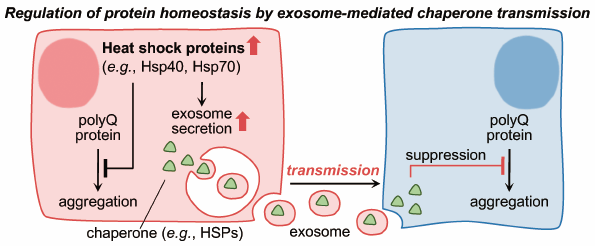 Graphical Abstract Fullsize ImageView full abstractDownload PDF (1322K) Full view HTML
Graphical Abstract Fullsize ImageView full abstractDownload PDF (1322K) Full view HTML
-
Tetsusuke Yoshimoto, Emi Ryu, Shiro Tomiyasu, Minoru Hojo, Hideya Koku ...2018Volume 41Issue 6 Pages 850-857
Published: June 01, 2018
Released on J-STAGE: June 01, 2018
Advance online publication: March 10, 2018JOURNAL FREE ACCESS FULL-TEXT HTMLPure oxycodone injection became increasingly necessary after oral oxycodone was launched in Japan in 2003. However, trials clarifying the efficacy and safety of injection are rare. Therefore, a multicenter open study on injection was designed and carried out in 2010, resulting in the launch of injection therapy in 2012. As published domestic case reports on efficacy already show widespread prescription, this study aimed to provide useful information for cancer pain relief in Japan and other countries. Our oxycodone injection study consisted of two trials, one of intravenous (S#9131) and the other of subcutaneous (S#9132) administration. The minimum required number of enrolled patients suffering cancer pain was determined to be 70 in S#9131 and 20 in S#9132. These studies had the same dose-titration protocol as the main endpoint, i.e., pain relief rate (PRR) defined as the rate of achieving adequate pain control (APC), as in prior oral oxycodone trials in Japan. In S#9131, PRR was 81.4% (95% confidence interval: 70.3–89.7%), therefore, the null hypothesis of PRR<70% was rejected using the binominal one-sided test (p=0.0217). In S#9132, PRR was 73.7% also surpassing 70%. Safety was also assessed in the same way as in prior trials. The majority of adverse effects were moderate or mild and recovered with no sequelae. As shown above, the injection was considered to be effective and safe in cancer pain treatment. The details of these trials, particularly the dose-titration protocol for achieving APC and route switching information, are expected to enhance injection convenience for prescribers.
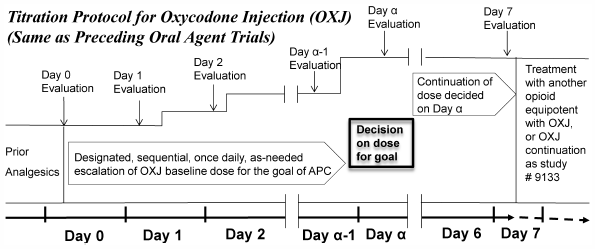 Graphical Abstract Fullsize ImageView full abstractDownload PDF (510K) Full view HTML
Graphical Abstract Fullsize ImageView full abstractDownload PDF (510K) Full view HTML -
Masami Yamada, Chikako Matsumura, Yumi Jimaru, Rie Ueno, Kazushige Tak ...2018Volume 41Issue 6 Pages 858-863
Published: June 01, 2018
Released on J-STAGE: June 01, 2018
JOURNAL FREE ACCESS FULL-TEXT HTMLFor improving the QOL of patients diagnosed with cancer, early palliative care is recommended, aiming to minimize pain and opioid-induced side effects. Herein, we evaluated the effect of continuous interventions for pain management and opioid-induced side effects in outpatients with cancer. Pharmacists continuously performed interventions on patients on their hospital visits, starting from the first visit for opioid introduction to intervention via telephone. We recorded their pain patterns and intensities, use of rescue doses, and types and degrees of side effects during these interventions. The physicians were suggested appropriate recommendations for increased doses or alternative opioids when the pharmacists considered the analgesic dose should be titrated. During the study period, palliative care pharmacists conducted 105 interviews for 27 patients (male: 19 and female: 8) with cancer pain. Pain intensities significantly decreased after the pharmacists’ continuous intervention, including those from telephone interviews, with their appropriate recommendations and increased opioid doses. Side effects such as nausea and constipation increased or remained unaffected even after the intervention, likely due to the increased opioid doses. Approximately 90% of recommendations for pain control were accepted by the physicians and helped to control the pain intensities. Before starting physician consultations, pharmacists informed the patients that adequate pain control and side effect management were achievable through regular interviews, wherein patient symptoms were monitored and patients received detailed explanations of pharmaceutical care and courteous and continuous counseling.
 Graphical Abstract Fullsize ImageView full abstractDownload PDF (380K) Full view HTML
Graphical Abstract Fullsize ImageView full abstractDownload PDF (380K) Full view HTML -
Satoshi Murakami, Yuichi Tasaka, Shingo Takatori, Akihiro Tanaka, Hiro ...2018Volume 41Issue 6 Pages 864-868
Published: June 01, 2018
Released on J-STAGE: June 01, 2018
JOURNAL FREE ACCESS FULL-TEXT HTMLUlcerative colitis (UC) is a refractory disease that causes chronic inflammation or ulceration in the mucosa of the large intestine with multiple relapses. Although several drugs, including 5-aminosalicylic acid, steroids, immunosuppressants, and infliximab, are used for UC therapy, patients suffer from side effects of these drugs, and a new safer therapeutic agent is desired. Eucommia ulmoides OLIV. leaf extract (ELE) has an anti-inflammatory effect. Therefore, we examined the effect of ELE on UC using a chronic dextran sulfate sodium (DSS)-induced colitis model in mice. Chronic DSS-induced colitis was triggered by alternately repeating 5 days’ DSS and 7 days’ water administration in mice for 29 d. The severity of DSS-induced colitis was evaluated by daily body weight and bloody stool score, and colon length and myeloperoxidase (MPO) activity in colon tissue on day 29. ELE (3 or 9%) was administered in combination by feeding for 29 d, and the effect on colitis was evaluated. The mice given DSS exhibited chronic colitis symptoms with body weight loss, increased bloody stool score and MPO activity, and shortened colon length. Administration of 3 or 9% ELE suppressed the body weight loss, bloody stool score, colon shortening, and MPO activity in a dose-dependent manner. Histological analysis showed that the ELE-treated mice had less damages and leukocyte infiltration in the mucosal layer of the large intestine compared to DSS alone group. These results suggested that ELE has the potential to prevent the development of DSS-induced colitis and a therapeutic effect on UC in a safe manner.
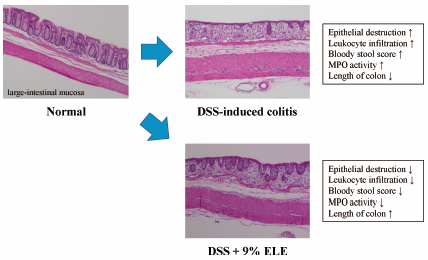 Graphical Abstract Fullsize ImageView full abstractDownload PDF (3561K) Full view HTML
Graphical Abstract Fullsize ImageView full abstractDownload PDF (3561K) Full view HTML -
Shun Guo, Song Zhang, Linna Liu, Peng Yang, Xueliang Dang, Huamei Wei, ...2018Volume 41Issue 6 Pages 869-876
Published: June 01, 2018
Released on J-STAGE: June 01, 2018
Advance online publication: April 04, 2018JOURNAL FREE ACCESS FULL-TEXT HTMLPinelliae Rhizoma Praeparatum (PRP) as traditional Chinese medicine had been used for hepatic diseases in combinative forms. However, the effect of PRP was not clear when used alone. So to explore the hepatoprotective/hepatotoxin of PRP is necessary. The activities of PRP were investigated in acetaminophen-induced hepatic injury mice. Liver function markers, hepatic oxidative stress markers were evaluated. Bile acids metabolic transports and nuclear factor erythroid 2-related factor 2 (Nrf2) were detected. As a drug for the treatment of liver diseases, PRP slightly restored the parameters towards normal in model mice only in low dosage, and also had no antioxidant activity and regulate Nrf2. Cholestasis was significantly elevated in model mice when pretreatment with routine or high dosage of PRP, but had no effect on normal mice. Bile salt export pump (Bsep) and multidrug resistance-associated protein 2 (Mrp2) in model mice were markedly increased when pretreatment with low dose PRP, but significantly decreased when pretreatment in routine or high dosage. Mrp3 was significantly induced in model mice after pretreatment of PRP. But the adjustment effect to bile acids transporters by PRP was not significant in normal mice. These results reveal that PRP has the different effects on bile acids transporter in hepatic injury mice, and therefore, the dosage of PRP need to be paid attention to when it is used in clinical hepatic injury.
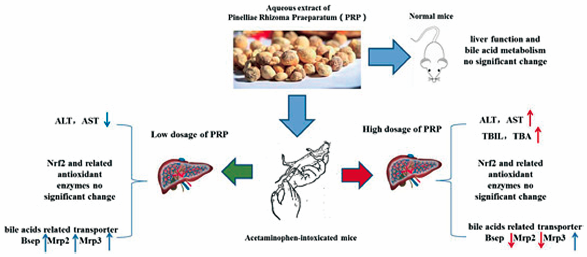 Graphical Abstract Fullsize ImageView full abstractDownload PDF (12393K) Full view HTML
Graphical Abstract Fullsize ImageView full abstractDownload PDF (12393K) Full view HTML -
Masafumi Takeno, Shinya Kitagawa, Junpei Yamanaka, Mayumi Teramoto, Ha ...2018Volume 41Issue 6 Pages 877-884
Published: June 01, 2018
Released on J-STAGE: June 01, 2018
JOURNAL FREE ACCESS FULL-TEXT HTML
Supplementary materialThe risk of rheumatoid arthritis (RA) is linked to environmental and genetic factors. Cigarette smoking is an established environmental risk factor for the disease that contributes to its development and severity. Previously, we found that cigarette smoke condensate (CSC), both mainstream and sidestream, aggravates collagen type II-induced arthritis (CIA), which was observed following either intraperitoneal inoculation or nasal exposure. In the present study, we aimed to identify the compound in CSC, which aggravates CIA. By sequential fractionation and analysis, extraction with water/ether in different pH values, silica gel column chromatography, TLC, octadecyl silica (ODS) HPLC, GC/MS, and NMR, the active compound was identified as 5-hydroxy-2-methylpyridine (5H2MP). Its isomer 2-hydroxy-3-methylpyridine, but not 3-hydroxy-2-methylpyridine, was also active. 5H2MP was not mutagenic, and did not exhibit aryl hydrocarbon receptor-dependent activity. Our data help clarify the mechanism underlying the pathogenic effects of cigarette smoking on RA.
 Graphical Abstract Fullsize ImageView full abstractDownload PDF (551K) Full view HTML
Graphical Abstract Fullsize ImageView full abstractDownload PDF (551K) Full view HTML -
Zhen-zhen Yuan, You-rui Suo, Xue-yan Hao, Shu-lin Wang, Gang Li, Hong- ...2018Volume 41Issue 6 Pages 885-890
Published: June 01, 2018
Released on J-STAGE: June 01, 2018
Advance online publication: April 03, 2018JOURNAL FREE ACCESS FULL-TEXT HTMLSix triterpenic acids were separated and purified from the ethyl acetate extractive fraction of ethanol extracts of Potentilla parvifolia FISCH. using a variety of chromatographic methods. The neuroprotective effects of these triterpenoids were investigated in the present study, in which the okadaic acid induced neurotoxicity in human neuroblastoma SH-SY5Y cells were used as an Alzheimer’s disease cell model in vitro. The cell model was established with all trans-retinoic acid (5 µmol/L, 4 d) and okadaic acid (40 nmol/L, 6 h) treatments to induce tau phosphorylation and synaptic atrophy. Subsequently, the neuroprotective effects of these triterpenic acids were evaluated in vitro by this cell model. Results from the Western blot and morphology analysis suggested that compounds 3–6 had the better neuroprotective effects. Furthermore, we tested the level of mitochondrial reactive oxygen species and mitochondrial membrane potential of these compounds in SH-SY5Y cells by flow cytometry technology to investigate the potential neuroprotective mechanism of these compounds. All of the results indicated that maybe the mechanism of compounds 5 and 6 is to protect the cell from mitochondrial oxidative stress injuries.
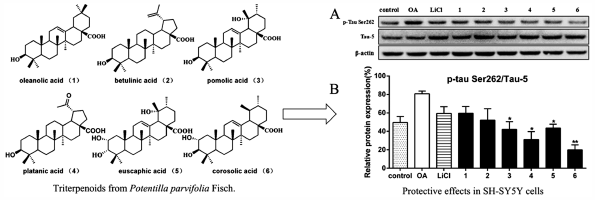 Graphical Abstract Fullsize ImageView full abstractDownload PDF (1254K) Full view HTML
Graphical Abstract Fullsize ImageView full abstractDownload PDF (1254K) Full view HTML -
Jie Hao, Kaipeng Huang, Cheng Chen, Yan Liang, Yu Wang, Xiaojian Zhang ...2018Volume 41Issue 6 Pages 891-898
Published: June 01, 2018
Released on J-STAGE: June 01, 2018
JOURNAL FREE ACCESS FULL-TEXT HTMLPrevious investigations on diabetic rats and palmitic corrosive instigated insulin-resistant HepG2 cells have shown that polydatin exhibits hypoglycemic and hypolipidemic impacts. The AMP-activated protein kinase (AMPK) pathway assumes a crucial part in glucose and lipid digestion. We aimed to investigate the regulatory system of polydatin on the glucose and lipid metabolism through the AMPK pathway. Glucose take-up, utilization levels, and oil red O recoloring were distinguished to confirm their impact on improving insulin resistance. A Western blot examination was utilized to investigate the phosphorylation levels of protein kinase B (Akt), glycogen synthase kinase (GSK)-3β, AMPK, acetyl-CoA carboxylase (ACC), and in addition the protein levels of the low-density lipoprotein receptor (LDLR) and sterol regulatory element-binding protein (SREBP)-1c. SREBP-1c nuclear translocation levels were recognized by a laser checking confocal magnifying instrument. One hundred nanomolar insulin treated for 24 h significantly declined the phosphorylation of Akt and AMPK, and increased the nucleoproteins of SREBP-1c compared with HepG2 cells without insulin. The insulin-resistant HepG2 cells prompted by insulin mediated the impact of polydatin on glucose and lipid digestion. Polydatin decreased glucose and lipid digestion of insulin-resistant HepG2 cells. Moreover, polydatin markedly raised phosphorylated Akt, GSK-3β, AMPK, ACC, diminished nuclear protein levels of SREBP-1c, and upgraded the protein levels of LDLR. Regulation of the AMPK pathway and changes in LDLR protein expression are potential focuses of polydatin in the treatment of insulin protection in insulin-resistant HepG2 cells.
 Graphical Abstract Fullsize ImageView full abstractDownload PDF (5210K) Full view HTML
Graphical Abstract Fullsize ImageView full abstractDownload PDF (5210K) Full view HTML -
Yoshinori Morikawa, Tatsuaki Tagami, Akihiro Hoshikawa, Tetsuya Ozeki2018Volume 41Issue 6 Pages 899-907
Published: June 01, 2018
Released on J-STAGE: June 01, 2018
JOURNAL FREE ACCESS FULL-TEXT HTMLMicrofluidics is a promising system for efficiently optimizing the experimental conditions for preparing nanomedicines, such as self-assembled nanoparticles. Poly(lactic-co-glycolic acid) (PLGA) nanoparticles are promising drug carriers allowing sustained drug release. Here, we encapsulated the model drug curcumin, which has many pharmacological activities, into PLGA nanoparticles and investigated the effects of experimental conditions on the resulting PLGA nanoparticles using a microfluidics system with a staggered herringbone structure that can stir solutions through chaotic advection. The total flow rate and flow rate ratio of the solutions in the microfluidics system affected the diameters, polydispersity index, and encapsulation efficiency of the resulting PLGA nanoparticles and produced small, homogenous PLGA nanoparticles. The incorporation of polyethylene glycol (PEG)–PLGA into the PLGA nanoparticles reduced the particle size and improved the encapsulation efficiency. Initial burst release from the PLGA nanoparticles was prevented by the incorporation of PEG2000–PLGA. Curcumin-loaded PEGylated PLGA nanoparticles showed cytotoxicity similar to that of other formulations. This microfluidics system allows high throughput and is scalable for the efficient preparation of PLGA nanoparticles and PEGylated PLGA nanoparticles. Our results will be useful for developing novel PLGA-based polymer nanoparticles by using the microfluidics.
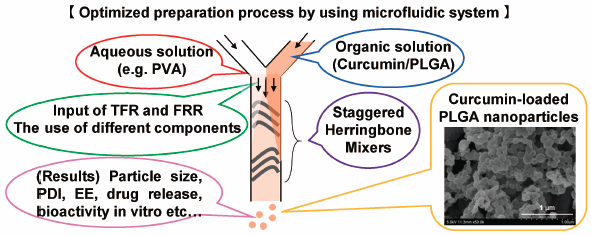 Graphical Abstract Fullsize ImageView full abstractDownload PDF (1135K) Full view HTML
Graphical Abstract Fullsize ImageView full abstractDownload PDF (1135K) Full view HTML -
Akihiro Hoshikawa, Mizuki Nagira, Masafumi Tane, Kaori Fukushige, Tats ...2018Volume 41Issue 6 Pages 908-914
Published: June 01, 2018
Released on J-STAGE: June 01, 2018
JOURNAL FREE ACCESS FULL-TEXT HTMLGold nanoparticles (GNPs) have promising properties such as photothermal effects and could be useful for imaging and as multifunctional nanocarriers for various drugs. In this study, we synthesized polyethyleneglycol (PEG)-grafted GNPs and conjugated them with cyclodextrin (CD) to incorporate curcumin. Curcumin has anticancer effects but its therapeutic application is limited due to poor water solubility. Three types of CDs (α-, β-, and γ-CDs) were conjugated with PEGylated GNPs and the curcumin-containing CD/PEG-conjugated GNPs (cur-CD-GNPs) were characterized. Transmission electron microscopy and dynamic light scattering results showed that these cur-CD-GNPs have a small gold nanocore (approximately 5 nm) and the average size of the three cur-CD-GNPs was approximately 25–35 nm. Curcumin was efficiently incorporated into the β-CD solution and the loading efficiency of curcumin in β-CD-GNPs was the highest of the three types of CD-GNPs prepared. The cytotoxic effect of cur-CD-GNPs was investigated using a human lung cancer cell line. All cur-CD-GNPs exhibited cytotoxic effects comparable to that of curcumin solution and CD-GNPs without curcumin were not cytotoxic. These results suggest that cur-CD-GNPs may be a useful multifunctional nanomedicine, although in vivo investigations are required.
 Graphical Abstract Fullsize ImageView full abstractDownload PDF (2035K) Full view HTML
Graphical Abstract Fullsize ImageView full abstractDownload PDF (2035K) Full view HTML -
Tomoji Maeda, Yu Fujita, Chiaki Tanabe-Fujimura, Kun Zou, Junjun Liu, ...2018Volume 41Issue 6 Pages 915-919
Published: June 01, 2018
Released on J-STAGE: June 01, 2018
JOURNAL FREE ACCESS FULL-TEXT HTML
Supplementary materialHomocysteine-inducible endoplasmic reticulum (ER) protein (Herp) is an ER stress-inducible membrane protein involved in ER-associated degradation. Herp expression is maintained at low levels through a strict regulatory mechanism, but the details of this mechanism and the reasons why Herp expression is restricted in this manner remain unclear. Here, we show that Herp degradation involves synoviolin, an ER-resident E3 ubiquitin ligase. Herp protein levels were found to be markedly elevated in synoviolin-null cells, and Herp expression decreased when synoviolin was overexpressed. However, the lysine residues of Herp, which are ubiquitinated by E3 ubiquitin ligase, were not sufficient for regulation of Herp degradation. These results suggest that Herp degradation is mediated via synoviolin and that Herp ubiquitination involves amino acids other than lysine.
 Graphical Abstract Fullsize ImageView full abstractDownload PDF (924K) Full view HTML
Graphical Abstract Fullsize ImageView full abstractDownload PDF (924K) Full view HTML -
Haruna Tamano, Hiroki Morioka, Haruka Iwaki, Hiroki Suzuki, Yuichi Sat ...2018Volume 41Issue 6 Pages 920-924
Published: June 01, 2018
Released on J-STAGE: June 01, 2018
JOURNAL FREE ACCESS FULL-TEXT HTMLOn the basis of the data that yokukansan (YKS), a herbal medicine, ameliorates aggressive behavior and abnormal glucocorticoid secretion of socially isolated mice under zinc deficiency, we tested whether YKS preventively buffers crowding stress-induced attenuations of glucocorticoid secretion response and long-term potentiation (LTP), an index of cognition. YKS-containing water was administered during the period of exposure to social crowding stress for 3 weeks. Serum corticosterone level was not significantly modified by administration of YKS-containing water and was also not increased after social-crowding stress. When vasopressin was injected into crowding-stressed rats to assess corticosterone secretion via pituitary–adorenocortical axis activation, vasopressin-induced increase in serum corticosterone was significantly attenuated compared to non-stressed control rats, indicating that the pituitary–adrenocortical response to vasopressin is affected after exposure to crowding stress. Interestingly, administration of YKS-containing water rescued attenuation of vasopressin-induced increase in serum corticosterone. LTP at Schaffer collateral-CA1 pyramidal cells synapses was attenuated in the hippocampal slices from crowding-stressed rats, while administration of YKS-containing water rescued the attenuation. The present study demonstrates that intake of YKS rescues crowding stress-induced impairments of glucocorticoid secretion response to vasopressin and hippocampal LTP. The intake of YKS may be benefit to buffering chronic stress.
 Graphical Abstract Fullsize ImageView full abstractDownload PDF (476K) Full view HTML
Graphical Abstract Fullsize ImageView full abstractDownload PDF (476K) Full view HTML -
 Airi Ohsaki, Yuki Miyano, Rei Tanaka, Sei-ichi Tanuma, Shuji Kojima, M ...2018Volume 41Issue 6 Pages 925-936
Airi Ohsaki, Yuki Miyano, Rei Tanaka, Sei-ichi Tanuma, Shuji Kojima, M ...2018Volume 41Issue 6 Pages 925-936
Published: June 01, 2018
Released on J-STAGE: June 01, 2018
Advance online publication: March 16, 2018JOURNAL FREE ACCESS FULL-TEXT HTML
Supplementary materialSkin inflammation is caused by excessive production of cytokines and chemokines in response to an external stimulus, such as radiation, but the mechanisms involved are not completely understood. Here, we report a novel mechanism of γ-irradiation-induced interleukin-6 (IL-6) production mediated by P2Y11 receptors in epidermal cells. After irradiation of HaCaT cells derived from human epidermal keratinocytes with 5 Gy of γ-rays (137Cs: 0.78 Gy/min), IL-6 production was unchanged at 24 h after γ-irradiation, but was increased at 48 h. IL-6 mRNA was increased at 30 h, and IL-6 production was increased at 33 h after irradiation. The production of IL-6 was sustained at least for 4 d after irradiation. P2Y11 receptor antagonist NF157 inhibited IL-6 production in irradiated cells. Treatment with ATP, a ligand of P2Y11 receptor caused IL-6 production within 24 h. ATP-induced IL-6 production was also suppressed by NF157. Extracellular ATP level was increased after irradiation. The p38 mitogen-activated protein kinase (MAPK) and nuclear factor-kappaB (NF-κB) signaling was involved in the production of IL-6 at the downstream of P2Y11 receptor activation. In addition, the cell cycle was arrested at the G2/M phase, and DNA repair foci were not disappeared at 48 h after γ-irradiation. The protein level of histone methylation enzyme G9a, which inhibits IL-6 production, was decreased after γ-irradiation. In conclusion, we suggest that γ-irradiation induces sustained IL-6 production in HaCaT cells from 33 h after irradiation, which is mediated through P2Y11 receptor-p38 MAPK-NF-κB signaling pathway and G9a degradation. This is a novel mechanism of cytokine production in γ-irradiated cells.
 Graphical Abstract Fullsize ImageView full abstractEditor's pick
Graphical Abstract Fullsize ImageView full abstractEditor's pickThe article by Ohsaki et al. proposed a novel mechanism of cytokine production in γ-irradiated cells. γ-Ray irradiation induced sustained IL-6 production in HaCaT epidermal cells from 33 h after irradiation. Extracellular ATP-induced activation of P2Y11 receptor was involved in the production of IL-6. At the downstream of P2Y11 receptor activation, the p38 MAPK and NF-kB signaling was involved in IL-6 production. The protein level of G9a, which inhibits IL-6 production, was decreased after g-irradiation. These findings should be helpful to understand the pathogenesis of radiation-induced inflammation, as well as the potential side effects of therapeutic irradiation.
Download PDF (5284K) Full view HTML -
Takehiro Noda, Tomoyuki Okuda, Ryota Mizuno, Tetsuya Ozeki, Hirokazu O ...2018Volume 41Issue 6 Pages 937-943
Published: June 01, 2018
Released on J-STAGE: June 01, 2018
JOURNAL FREE ACCESS FULL-TEXT HTMLIn the development of drugs for intra-articular administration, sustained-release formulations are desirable because it is difficult to maintain the effect of conventional injections due to immediate drug leakage from the joint cavity. In this study, a sustained-release poly(lactic-co-glycolic acid) (PLGA) microsphere formulation for intra-articular administration containing indocyanine green (ICG) as a model drug was prepared to follow its fate after intra-articular administration in rats with a real-time in-vivo imaging system. ICG administered as an aqueous solution leaked from the joint cavity in a short time and was excreted outside the body within 1–3 d. However, ICG in the sustained-release formulation was retained in the joint cavity and released for 2 weeks. Next, a sustained-release formulation containing PLGA microspheres in a hyaluronic acid (HA) gel formulation was prepared. After gradual release in two stages, we could achieve sustained release for a longer period. It is considered that a combination formulation of PLGA microspheres and HA gel can significantly improve the sustained release of a drug administered into the knee joint.
 Graphical Abstract Fullsize ImageView full abstractDownload PDF (4245K) Full view HTML
Graphical Abstract Fullsize ImageView full abstractDownload PDF (4245K) Full view HTML -
Ayana Haraguchi, Yuki Fuchigami, Maho Kawaguchi, Shintaro Fumoto, Kana ...2018Volume 41Issue 6 Pages 944-950
Published: June 01, 2018
Released on J-STAGE: June 01, 2018
JOURNAL FREE ACCESS FULL-TEXT HTML
Supplementary materialWe developed a tissue suction-mediated transfection method (suction method) as a relatively reliable and less invasive technique for in vivo transfection. In this study, we determined hepatic transgene expression characteristics in the mouse liver, using a suction device, collecting information relevant to gene therapy and gene functional analysis by the liver suction method. To achieve high transgene expression levels, we developed a suction device with four holes (multiple hole device) and applied it to the larger portion of the left lateral lobe of the mouse liver. Hepatic transfection with physical stimuli was potentially controlled by activator protein-1 (AP-1) and nuclear factor kappa-light-chain-enhancer of activated B cells (NF-κB). We examined the spatial distribution of transgene expression in the suctioned lobe by 2-dimensional imaging with histochemical staining and 3-dimensional multicolor deep imaging with tissue clearing methods. Through monitoring spatial distribution of transgene expression, the liver suction method was used to efficiently transfect extravascular hepatocytes in the suction-deformable upper lobe of the liver. Moreover, long-term transgene expression, at least 14 d, was achieved with the liver suction method when cytosine-phosphate-guanine (CpG)-free plasmid DNA was applied.
 Graphical Abstract Fullsize ImageView full abstractDownload PDF (6740K) Full view HTML
Graphical Abstract Fullsize ImageView full abstractDownload PDF (6740K) Full view HTML -
Yuuka Shibata, Yumeka Sagara, Tomoharu Yokooji, Takanori Taogoshi, Mai ...2018Volume 41Issue 6 Pages 951-956
Published: June 01, 2018
Released on J-STAGE: June 01, 2018
JOURNAL FREE ACCESS FULL-TEXT HTMLInadvertent leakage of noncytotoxic agents causes severe tissue injury. In this study, we macroscopically and histopathologically evaluated the extent of skin injury caused by extravasation of hyperosmolar or vasopressor agents in rats. Rats were intradermally administered saline (100 µL), the hyperosmolar agents mannitol (5–20 mg/100 µL) and glucose (5–50 mg/100 µL), or the vasopressors dopamine (2 mg/100 µL), adrenaline (0.1 mg/100 µL), and noradrenaline (0.1 mg/100 µL). Lesion size (erythema, induration, ulceration, and necrosis) was monitored after agent injection. Skin tissue biopsies were evaluated at 24 h after agent injection. Mannitol and glucose induced severe lesions in a concentration (and osmolarity)-dependent manner. Mannitol and glucose at 10–20% (w/v) induced inflammation, and lesions healed within 3–6 d. In contrast, ≥25% (w/v) glucose elicited severe skin lesions with ulceration and necrosis within 24 h, which healed gradually 16–22 d after injection. The severity of extravasation injury caused by vasopressors varied. Adrenaline and noradrenaline induced severe injury with ulceration and necrosis, which healed over 23.3 and 18.3 d, respectively. In contrast, dopamine induced erythema and induration, and damage duration was only 5.7 d. In conclusion, mannitol and glucose at osmolarities of 549–1098 and 833–1110 mOsm/L, respectively, can be classified as “irritants,” while ≥1388 mOsm/L glucose can be classified as a “vesicant.” As for vasopressors, adrenaline and noradrenaline can be classified as “vesicants” whereas dopamine can be classified as an “irritant.”
 Graphical Abstract Fullsize ImageView full abstractDownload PDF (4281K) Full view HTML
Graphical Abstract Fullsize ImageView full abstractDownload PDF (4281K) Full view HTML -
Kohei Takahashi, Osamu Nakagawasai, Masae Sugawara, Atsushi Sato, Wata ...2018Volume 41Issue 6 Pages 957-960
Published: June 01, 2018
Released on J-STAGE: June 01, 2018
JOURNAL FREE ACCESS FULL-TEXT HTMLOlfactory bulbectomized (OBX) mice are characterized by impaired performance in the passive avoidance test and decreased number of cholinergic neurons in the hippocampus. Several studies have reported that κ-opioid receptor agonists improve cognitive function in mice. However, their influence on OBX-induced cognitive dysfunction remains unclear. To address this question, we evaluated the effects of the endogenous κ-opioid receptor agonist dynorphin A (Dyn A) and the selective agonist trans-(−)-U-50488 on the behavior of OBX mice in the passive avoidance test. The cognitive dysfunction of OBX mice was significantly recovered by the intracerebroventricular administration of Dyn A or trans-(−)-U-50488. The effects of these two agonists were counteracted by the selective κ-opioid receptor antagonist nor-binaltorphimine or the inhibitor of acetylcholine release β-bungarotoxin. These findings suggest that κ-opioid receptor agonists produce anti-dementia effects through activation of cholinergic neurons in OBX mice.
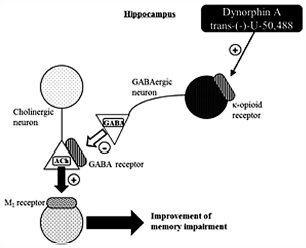 Graphical Abstract Fullsize ImageView full abstractDownload PDF (445K) Full view HTML
Graphical Abstract Fullsize ImageView full abstractDownload PDF (445K) Full view HTML
-
Mai Hazekawa, Kazuhiko Ono, Takuya Nishinakagawa, Tomoyo Kawakubo-Yasu ...2018Volume 41Issue 6 Pages 961-966
Published: June 01, 2018
Released on J-STAGE: June 01, 2018
Advance online publication: March 10, 2018JOURNAL FREE ACCESS FULL-TEXT HTMLSodium 4-phenylbutyrate (PBA), which exerts a wide range of anti-inflammatory effects, is rapidly cleared from the body (approximately 98%) by urinary excretion by 24 h after oral treatment in humans. PBA was almost entirely excreted to urine as phenylacetyl glutamine (PAGln). However, no data describe the potential anti-inflammatory effects of PAGln. The purpose of this study was to evaluate the anti-inflammatory effects of PAGln on mouse spleen cells and peritoneal cavity cells, and explore the potential mechanism underlying this effect. PAGln was added to mouse spleen cell cultures stimulated by concanavalin A, or mouse peritoneal cavity cell cultures stimulated by lipopolysaccharide. After 72 h of culture, levels of inflammatory cytokines in culture supernatants were measured using a sandwich enzyme-linked immunosorbent assay system, and levels of inflammatory proteins were assessed by Western blotting. PAGln significantly inhibited inflammatory cytokine (interferon-γ, interleukin-6, and tumor necrosis factor-α) production, decrease of cell number in the spleen cell, and suppressed the expression of inflammatory proteins (nuclear factor κB, and inducible nitric oxide synthase). These results suggest that PAGln possesses anti-inflammatory activity via inhibition of T cell activation and Toll-like receptor 4 signaling. This study of the anti-inflammatory mechanism of PAGln provides useful information about its potential for therapeutic applications.
 Graphical Abstract Fullsize ImageView full abstractDownload PDF (763K) Full view HTML
Graphical Abstract Fullsize ImageView full abstractDownload PDF (763K) Full view HTML -
Qiwei Li, Hanjing Yan, Dan Lin, Yesheng Wang, Mengling He, Weimin Zhan ...2018Volume 41Issue 6 Pages 967-971
Published: June 01, 2018
Released on J-STAGE: June 01, 2018
JOURNAL FREE ACCESS FULL-TEXT HTMLAquilaria LAM. is an endangered tropical tree that produces agarwood, a common ingredient in medicine, perfumes and incense. The species endemic to China, Aquilaria yunnanensis, is often misidentified as the two valuable species, Aquilaria sinensis and Aquilaria crassna. In present study, three DNA barcodes (internal transcribed spacer (ITS), maturase K gene (matK) and trnL-trnF) were used to evaluate whether these genes can be used to discriminate the three species, and evaluate the phylogenetic relationship between the three Aquilaria species. For accurate identification of the three Aquilaria species, a total of 26 nucleotide variations were detected when comparing the three DNA barcodes. We found that A. sinensis is closely related to A. crassna based on combination of nuclear and chloroplast DNA barcodes, and is closely related to A. yunnanensis based on chloroplast DNA barcodes. Taken together, we suggest that the combination of ITS+matK and ITS+trnL-trnF are suitable for identifying these three Aquilaria species.
 Graphical Abstract Fullsize ImageView full abstractDownload PDF (853K) Full view HTML
Graphical Abstract Fullsize ImageView full abstractDownload PDF (853K) Full view HTML -
Yuki Yamasaki, Kaoru Kobayashi, Kan Chiba2018Volume 41Issue 6 Pages 972-977
Published: June 01, 2018
Released on J-STAGE: June 01, 2018
JOURNAL FREE ACCESS FULL-TEXT HTML
Supplementary materialP-Glycoprotein (P-gp), encoded by the MDR1 (ABCB1) gene in humans and by Mdr1a and Mdr1b genes in rodents, is a member of the superfamily of ATP-binding cassette transporters. Since P-gp is constitutively expressed in numerous tissues and exhibits a broad specificity in substrate recognition, it can play a crucial role in limiting the absorption and distribution of xenobiotics by decreasing their intracellular accumulation. The expression of P-gp is regulated by various nuclear receptors such as pregnane X receptor (PXR). Although the characterization of P-gp induction by PXR ligands is a crucial goal for predicting pharmacokinetics of drugs, findings regarding the induction of P-gp by PXR ligands in vivo are still controversial. In this study, we examined the effect of pregnenolone 16α-carbonitrile (PCN), a murine PXR ligand, on the expression of Mdr1a/1b mRNA and P-gp protein in the intestine, brain and liver of mice. The results showed that PCN increased the expression of both Mdr1a/1b mRNA and P-gp protein in the intestine and the brain. The present study provided the first evidence that P-gp is inducible by PCN in the large intestine. The results also showed that P-gp protein was induced by PCN in the cortex but not in the whole brain. On the other hand, PCN increased the expression of Mdr1a/1b mRNA in the liver, although no increase was observed in the expression of P-gp protein. These results suggested different effect of PCN on the expression of P-gp protein in the intestine, brain and liver of mice.
 Graphical Abstract Fullsize ImageView full abstractDownload PDF (884K) Full view HTML
Graphical Abstract Fullsize ImageView full abstractDownload PDF (884K) Full view HTML
- |<
- <
- 1
- >
- >|